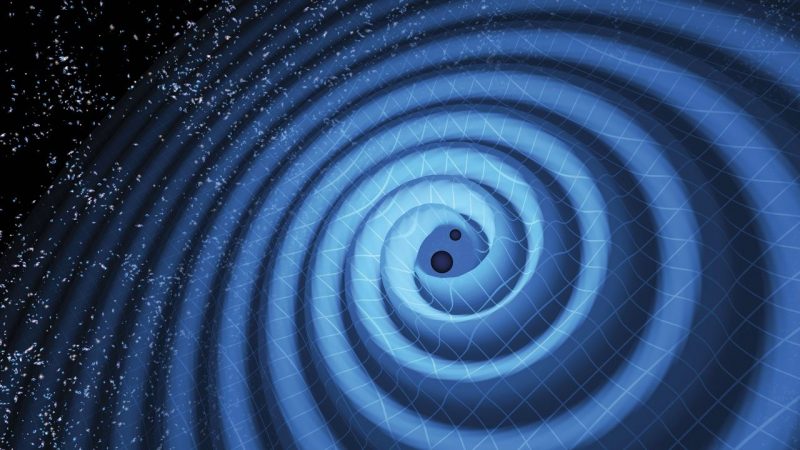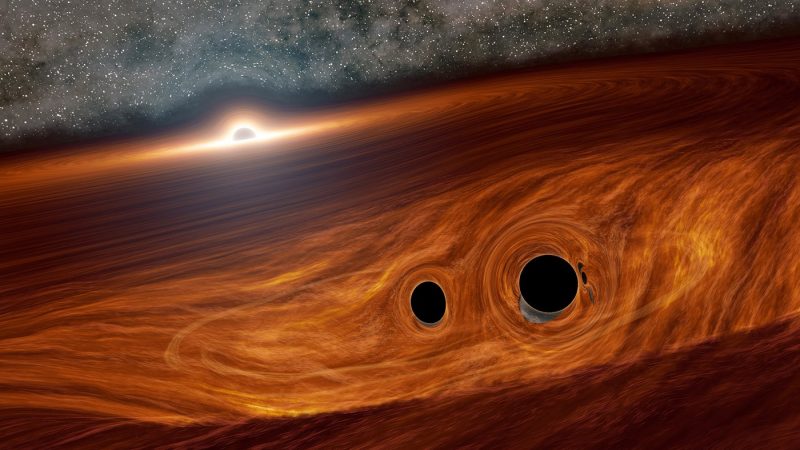

Artist’s concept of an array of pulsars, used in a system to find black holes with billions of times our sun’s mass. The best place to start? One idea is to use the gravitational center of our solar system. Image via David Champion/ Vanderbilt University.
Black holes are places where gravity is so immense that light cannot escape. The spacetime surrounding black holes is warped. In recent decades, astronomers have come to believe that largest black holes – supermassive black holes – reside in the hearts of most galaxies. Each is millions or billions of times the mass of our sun. But many supermassive black holes remain undetected. How can scientists find them? Enter gravitational waves, ripples in spacetime, theorized as far back as Albert Einstein, but observed only since 2015. Astronomers now say we can find supermassive black holes by observing the effect of their gravitational waves on the timing of light flashes from pulsars. While conducting this research, these scientists say they’ve also refined our knowledge of the gravitational center – or barycenter – of our solar system.
The new research comes from Stephen Taylor, assistant professor of physics at Vanderbilt University and the North American Nanohertz Observatory for Gravitational Waves (NANOGrav) collaboration. Taylor explained in a statement:
Using the pulsars we observe across the Milky Way galaxy, we are trying to be like a spider sitting in stillness in the middle of her web. How well we understand the solar system’s barycenter is critical as we attempt to sense even the smallest tingle to the web.
This new technique for finding supermassive black holes was announced on June 30, 2020 by Vanderbilt University.
The peer-reviewed paper detailing their findings was published in The Astrophysical Journal last April 21.
Gravitational waves – ripples in space-time – can be generated by pairs of black holes orbiting each other. To find these ripples, Taylor and his colleagues measure the regular flashes of light from pulsars, which are neutron stars that spin extremely fast and blast out beams of light, much like a cosmic lighthouse. The researchers are looking for changes in the arrival rate of these flashes, using NANOGrav data. Like clocks keeping time perfectly, pulsars are known to emit their flashes in a way that’s extremely regular (which is why, when first discovered, it was thought they might be artificial signals from aliens). So slight deviations from the otherwise regular flashing of a pulsar could indicate the passing of gravitational waves.

It turns out that the exact gravitational center – the barycenter – of the solar system is not in the middle of the sun, but rather about 330 feet (100 meters) above the sun’s surface, according to the new study. Image via Tonia Klein/ NANOGrav Physics Frontier Center/ Vanderbilt University.
In the statement from these scientists, Taylor said that understanding the exact location of the barycenter of the solar system helps in the search for gravitational waves from supermassive black holes. What is the barycenter, exactly? Perhaps you know that – as in the Earth-moon system, for example – the moon doesn’t orbit the center of Earth. Instead, both Earth and moon orbit around the barycenter, or common center of gravity in the system. In the Earth-moon system, the center of gravity, or barycenter, is inside Earth, but not at the center of Earth. It’s about 2,902 miles (4,671 km) from Earth’s center, or about 75% of the way from Earth’s center to its surface.
Likewise, the barycenter – or center of mass – in our solar system isn’t in the middle of the sun. It’s near the sun’s surface, about 330 feet (100 meters) above the sun’s surface, according to the new study. These scientists’ statement called this point “the location of absolute stillness in our solar system.”
So understanding the location of the exact gravitational center of the solar system helps scientists measure the very slight but detectable changes in pulsar flashes caused by passing gravitational waves. That location has been estimated before, using data from Doppler tracking. This provides the locations and trajectories of objects as they orbit the sun. But that can lead to errors and inconsistent results, showing evidence of gravitational waves that aren’t really there. Co-author Joe Simon said:
The catch is that errors in the masses and orbits will translate to pulsar-timing artifacts that may well look like gravitational waves.

Graphic depiction of gravitational waves generated by two black holes orbiting each other. Image via LIGO/ T. Pyle/ Science.

Artist’s concept of a peculiar black hole system, in which 2 small black holes are merging in the disk surrounding a 3rd, supermassive black hole. To find the most massive black holes, researchers are measuring the timing of light flashes coming from pulsars, as affected by gravitational waves. Image via Caltech/ R. Hurt (IPAC).
Lead author Michele Vallisneri added:
We weren’t detecting anything significant in our gravitational wave searches between solar system models, but we were getting large systematic differences in our calculations. Typically, more data delivers a more precise result, but there was always an offset in our calculations.
So how do the researchers account for the previous errors and inconsistencies, and improve the accuracy of detecting the gravitational waves? They decided to try a different approach, searching for the gravity waves and the exact gravitational center of the solar system at the same time. And it worked. They were even able to specifically pinpoint the center of gravity in the solar system to within 100 meters! The precise gravitational center of the solar system is not in the center of the sun, as might be presumed. It is actually only about 330 feet above the surface of the sun, according to the paper. This discrepancy is due to the affect of the huge mass of the largest planet, Jupiter. Taylor said:
Our precise observation of pulsars scattered across the galaxy has localized ourselves in the cosmos better than we ever could before. By finding gravitational waves this way, in addition to other experiments, we gain a more holistic overview of all different kinds of black holes in the universe.

Stephen Taylor at Vanderbilt University, co-author of the new study. Image via Vanderbilt University.
Just a few days ago, it was reported that, for the first time, astronomers had observed visible light from a black hole merger. In this system, two smaller black holes are merging together within a disk of material surrounding a supermassive black hole 12.8 billion light-years away. Such mergers have been detected before by the gravitational waves they create, but this was the first time that a flare-like visible light phenomenon had also been seen. The light comes from the gaseous disk of material surrounding the larger black hole, not from within the black holes themselves.
NANOGrav will continue to collect additional pulsar timing data, and astronomers are confident that this will lead to the unequivocal discovery of more supermassive black holes.
Bottom line: New study says that the best way to find the most massive black holes is to measure gravitational waves at the precise gravitational center of the solar system.
from EarthSky https://ift.tt/2CBGerA


Artist’s concept of an array of pulsars, used in a system to find black holes with billions of times our sun’s mass. The best place to start? One idea is to use the gravitational center of our solar system. Image via David Champion/ Vanderbilt University.
Black holes are places where gravity is so immense that light cannot escape. The spacetime surrounding black holes is warped. In recent decades, astronomers have come to believe that largest black holes – supermassive black holes – reside in the hearts of most galaxies. Each is millions or billions of times the mass of our sun. But many supermassive black holes remain undetected. How can scientists find them? Enter gravitational waves, ripples in spacetime, theorized as far back as Albert Einstein, but observed only since 2015. Astronomers now say we can find supermassive black holes by observing the effect of their gravitational waves on the timing of light flashes from pulsars. While conducting this research, these scientists say they’ve also refined our knowledge of the gravitational center – or barycenter – of our solar system.
The new research comes from Stephen Taylor, assistant professor of physics at Vanderbilt University and the North American Nanohertz Observatory for Gravitational Waves (NANOGrav) collaboration. Taylor explained in a statement:
Using the pulsars we observe across the Milky Way galaxy, we are trying to be like a spider sitting in stillness in the middle of her web. How well we understand the solar system’s barycenter is critical as we attempt to sense even the smallest tingle to the web.
This new technique for finding supermassive black holes was announced on June 30, 2020 by Vanderbilt University.
The peer-reviewed paper detailing their findings was published in The Astrophysical Journal last April 21.
Gravitational waves – ripples in space-time – can be generated by pairs of black holes orbiting each other. To find these ripples, Taylor and his colleagues measure the regular flashes of light from pulsars, which are neutron stars that spin extremely fast and blast out beams of light, much like a cosmic lighthouse. The researchers are looking for changes in the arrival rate of these flashes, using NANOGrav data. Like clocks keeping time perfectly, pulsars are known to emit their flashes in a way that’s extremely regular (which is why, when first discovered, it was thought they might be artificial signals from aliens). So slight deviations from the otherwise regular flashing of a pulsar could indicate the passing of gravitational waves.

It turns out that the exact gravitational center – the barycenter – of the solar system is not in the middle of the sun, but rather about 330 feet (100 meters) above the sun’s surface, according to the new study. Image via Tonia Klein/ NANOGrav Physics Frontier Center/ Vanderbilt University.
In the statement from these scientists, Taylor said that understanding the exact location of the barycenter of the solar system helps in the search for gravitational waves from supermassive black holes. What is the barycenter, exactly? Perhaps you know that – as in the Earth-moon system, for example – the moon doesn’t orbit the center of Earth. Instead, both Earth and moon orbit around the barycenter, or common center of gravity in the system. In the Earth-moon system, the center of gravity, or barycenter, is inside Earth, but not at the center of Earth. It’s about 2,902 miles (4,671 km) from Earth’s center, or about 75% of the way from Earth’s center to its surface.
Likewise, the barycenter – or center of mass – in our solar system isn’t in the middle of the sun. It’s near the sun’s surface, about 330 feet (100 meters) above the sun’s surface, according to the new study. These scientists’ statement called this point “the location of absolute stillness in our solar system.”
So understanding the location of the exact gravitational center of the solar system helps scientists measure the very slight but detectable changes in pulsar flashes caused by passing gravitational waves. That location has been estimated before, using data from Doppler tracking. This provides the locations and trajectories of objects as they orbit the sun. But that can lead to errors and inconsistent results, showing evidence of gravitational waves that aren’t really there. Co-author Joe Simon said:
The catch is that errors in the masses and orbits will translate to pulsar-timing artifacts that may well look like gravitational waves.

Graphic depiction of gravitational waves generated by two black holes orbiting each other. Image via LIGO/ T. Pyle/ Science.

Artist’s concept of a peculiar black hole system, in which 2 small black holes are merging in the disk surrounding a 3rd, supermassive black hole. To find the most massive black holes, researchers are measuring the timing of light flashes coming from pulsars, as affected by gravitational waves. Image via Caltech/ R. Hurt (IPAC).
Lead author Michele Vallisneri added:
We weren’t detecting anything significant in our gravitational wave searches between solar system models, but we were getting large systematic differences in our calculations. Typically, more data delivers a more precise result, but there was always an offset in our calculations.
So how do the researchers account for the previous errors and inconsistencies, and improve the accuracy of detecting the gravitational waves? They decided to try a different approach, searching for the gravity waves and the exact gravitational center of the solar system at the same time. And it worked. They were even able to specifically pinpoint the center of gravity in the solar system to within 100 meters! The precise gravitational center of the solar system is not in the center of the sun, as might be presumed. It is actually only about 330 feet above the surface of the sun, according to the paper. This discrepancy is due to the affect of the huge mass of the largest planet, Jupiter. Taylor said:
Our precise observation of pulsars scattered across the galaxy has localized ourselves in the cosmos better than we ever could before. By finding gravitational waves this way, in addition to other experiments, we gain a more holistic overview of all different kinds of black holes in the universe.

Stephen Taylor at Vanderbilt University, co-author of the new study. Image via Vanderbilt University.
Just a few days ago, it was reported that, for the first time, astronomers had observed visible light from a black hole merger. In this system, two smaller black holes are merging together within a disk of material surrounding a supermassive black hole 12.8 billion light-years away. Such mergers have been detected before by the gravitational waves they create, but this was the first time that a flare-like visible light phenomenon had also been seen. The light comes from the gaseous disk of material surrounding the larger black hole, not from within the black holes themselves.
NANOGrav will continue to collect additional pulsar timing data, and astronomers are confident that this will lead to the unequivocal discovery of more supermassive black holes.
Bottom line: New study says that the best way to find the most massive black holes is to measure gravitational waves at the precise gravitational center of the solar system.
from EarthSky https://ift.tt/2CBGerA

Aucun commentaire:
Enregistrer un commentaire